Featured Comment:
“This ramen recipe was so good! It was easy to make, too. The miso got it close to tasting like my favorite local restaurant ramen. I’ll definitely be making it this way from now on.”
– Misty
What is Miso Ramen?
What if I told you you could get authentic Japanese miso ramen in just 15 minutes on a busy weeknight?
This Hokkaido-born noodle dish from 1955 seems intimidating until you realize it’s actually the most approachable ramen for home kitchens. You’ve probably thought twice before making ramen at home, thinking it’s too complicated or time-consuming, but here’s the thing: miso paste can give you that instant depth you can skip the long cooking sessions like tonkotsu or shoyu ramen.
What sets my miso ramen recipe apart? Honoring the authentic flavor profile while embracing home cooking realities worldwide. My secret ingredient will probably surprise you. Ready to discover how remarkably simple and authentic it can be?
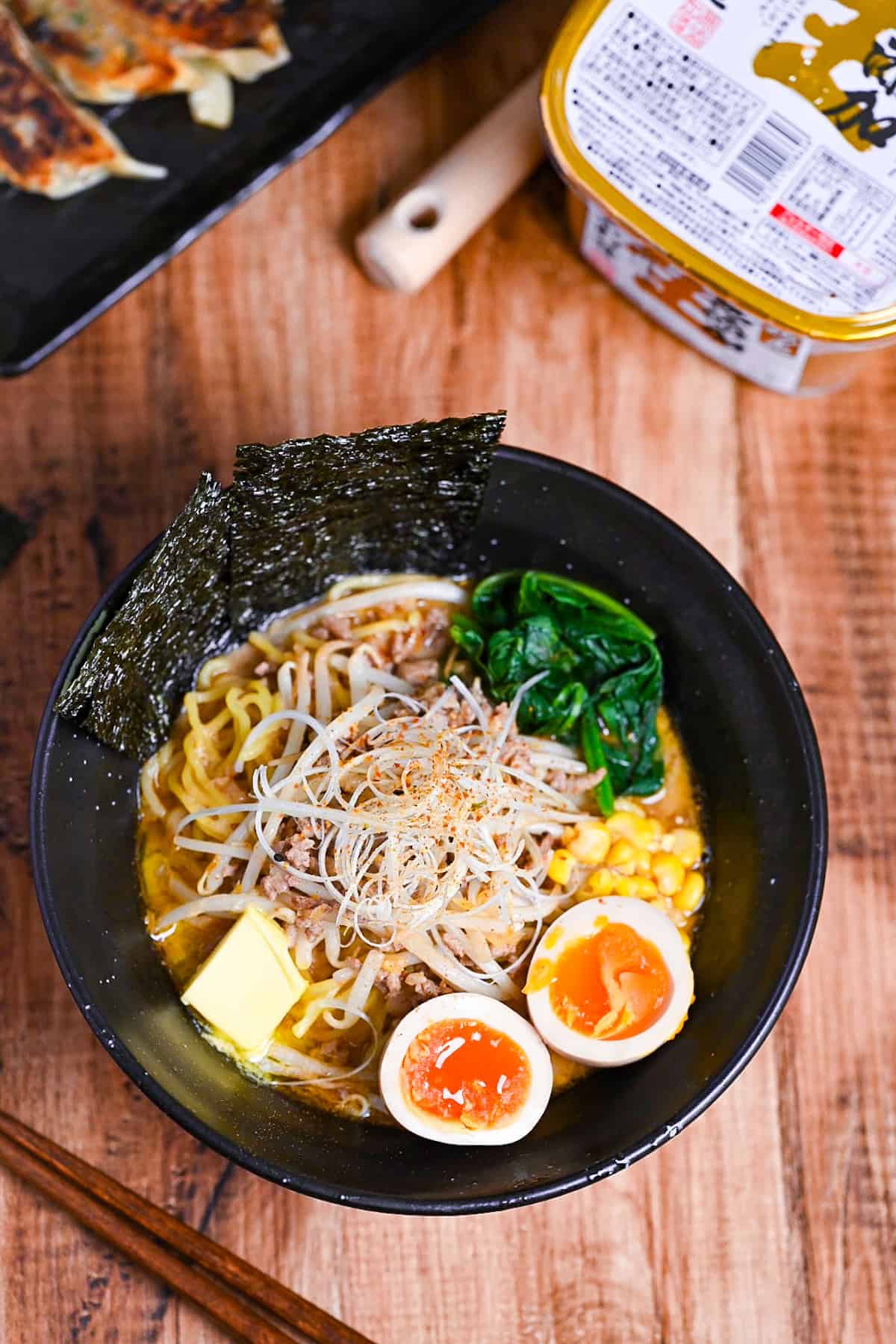
The Best Noodles for Miso Ramen
Choosing the right noodles can transform your miso ramen from good to extraordinary. Traditional Sapporo-style ramen typically uses medium-thick, wavy noodles. Why?
Let’s take a look at the different types of noodles and see what makes them perfect for a rich miso broth.
| Noodle Type | Thickness | Soup Grip | Cooking Time | Texture |
|---|---|---|---|---|
| Ultra-thin (極細麺) | 1.0-1.2mm | Low – slips off quickly | 1-2 minutes | Delicate, soft |
| Thin (細麺) | 1.2-1.5mm | Medium-low | 2-3 minutes | Tender |
| Medium (中細麺) | 1.5-1.7mm | Medium | 3-4 minutes | Balanced |
| Medium-thick (中太麺) | 1.7-2.2mm | High – ideal grip | 4-5 minutes | Chewy, substantial |
| Thick (太麺) | 2.2mm+ | Very high | 5-6 minutes | Very chewy |
Traditional Sapporo miso ramen uses medium-thick, high-hydration wavy noodles. These noodles were specifically developed for Hokkaido’s cold climate, featuring strong chewiness and resistance to becoming soggy.
Medium-thick noodles provide enough substance to stand up to rich miso broth without overpowering it. The high water content (35%+) creates that signature chewy texture that stays firm in hot soup, while eggs add richness and the traditional yellow color.

The wavy shape isn’t just aesthetic too! It controls how much soup each bite picks up. Straight noodles absorb more broth, potentially overwhelming your palate. The subtle waves allow just the right amount of flavorful broth to coat every bite without overpowering.
- If making noodles at home with a pasta machine, go for a 35% hydration dough with the spaghetti attachment (1.5mm). After cutting, gently scrunch them to form slight waves.
- Always undercook noodles by about 30 seconds according to package instructions for miso ramen.

Choosing the Right Miso Paste
The type of miso paste you select greatly shapes the taste profile of your miso ramen, creating the perfect balance between savory, sweet, and umami flavors. Here’s how common miso varieties compare:
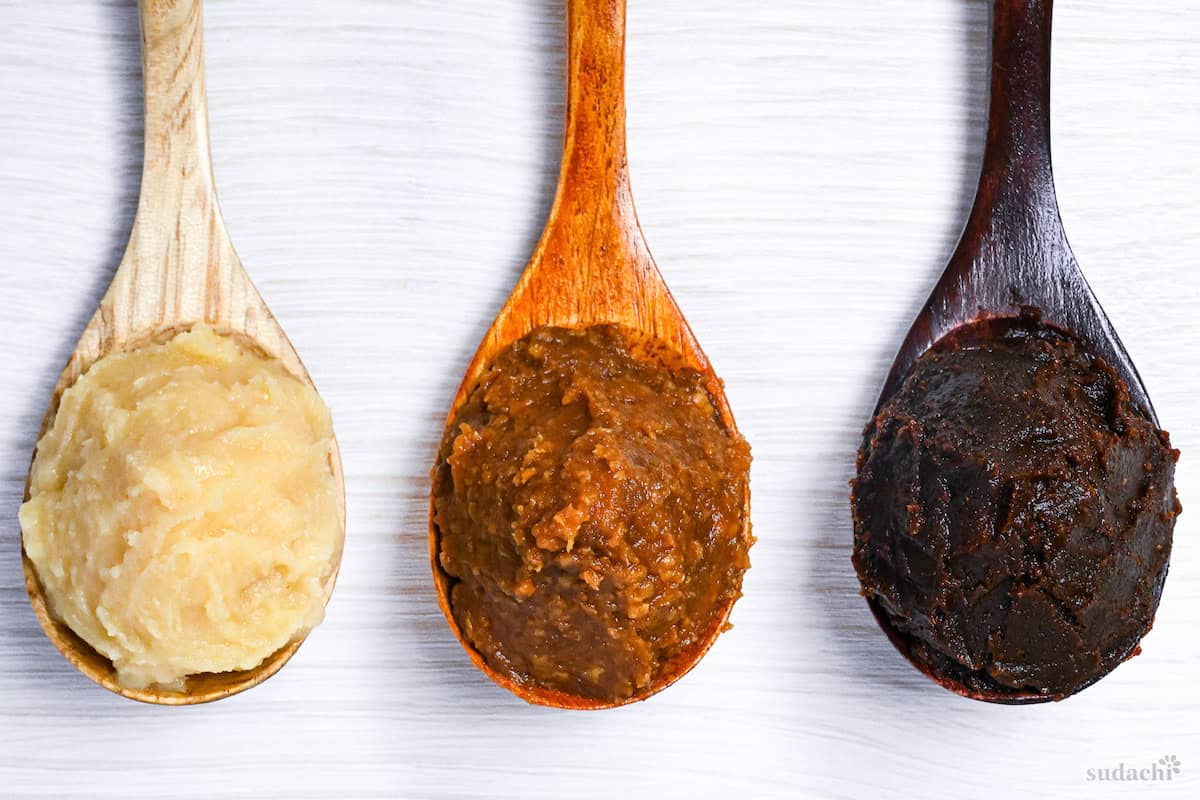
| Miso Type | Color | Flavor Profile |
|---|---|---|
| Red Miso | Dark reddish-brown | Salty, robust, complex umami |
| White Miso | Light beige/yellow | Sweet, mild, delicate |
| Mixed/Blended (Yellow) | Medium brown | Balanced sweet-savory |
| Barley Miso | Light to medium | Slightly sweet, nutty |
| Bean Miso | Very dark | Intense, astringent |
Classic Sapporo-style miso ramen usually blends miso types, typically combining red and white miso. Using only red miso can result in an overly salty and fermented flavor, while exclusively white miso might lack the depth and can make the soup overly simple and sweet.
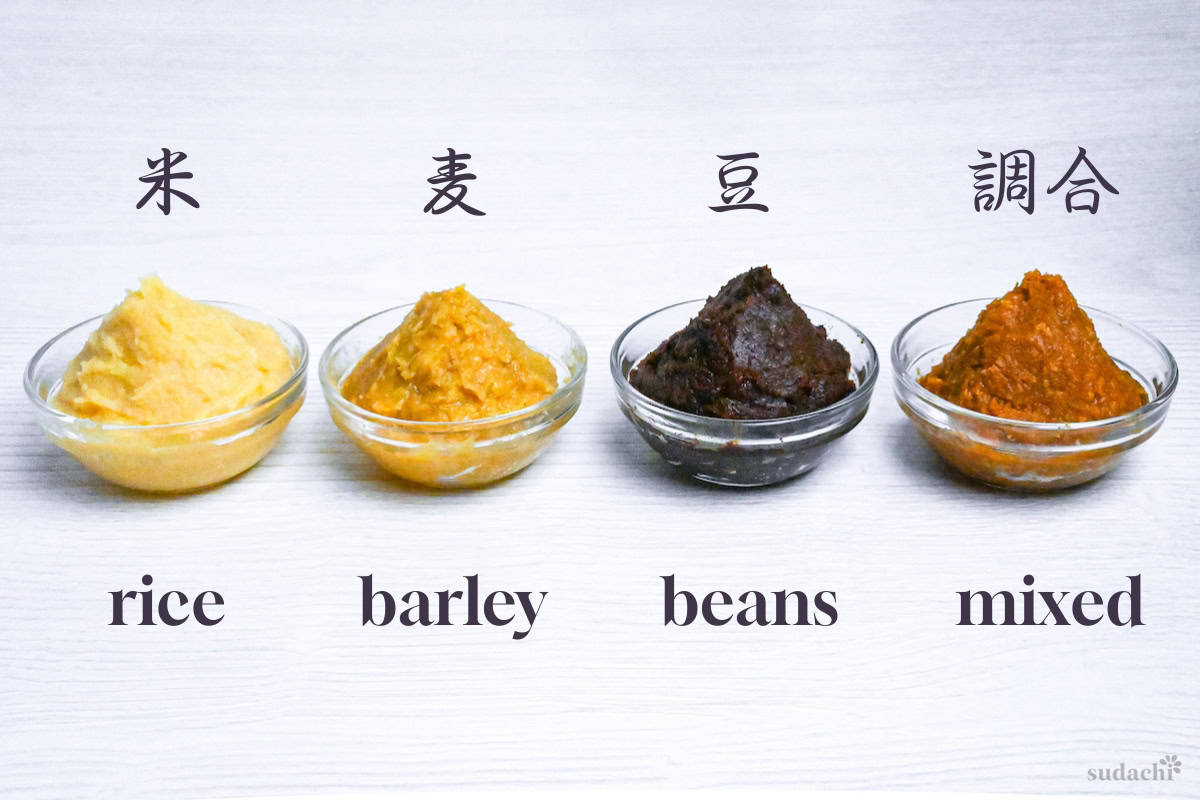
The good news? You can easily buy pre-blended miso at most Asian markets, often labeled as “yellow miso” in English, and it offers an ideal balance of flavors.
My personal recommendation: Take store-bought yellow miso and add just a touch of extra red miso. This small addition:
- Boosts the long-fermented melanoidin compounds for deeper color and flavor
- Increases glutamate content for enhanced umami
- Adds dimensional complexity to your miso base
That said, using 100% yellow miso straight from the package works perfectly fine!
- Easiest option: Pre-blended “yellow miso” (awase miso)
- My blend: Yellow miso + small amount of red miso
- Avoid: 100% extreme varieties like sweet saikyo miso or intense hatcho miso
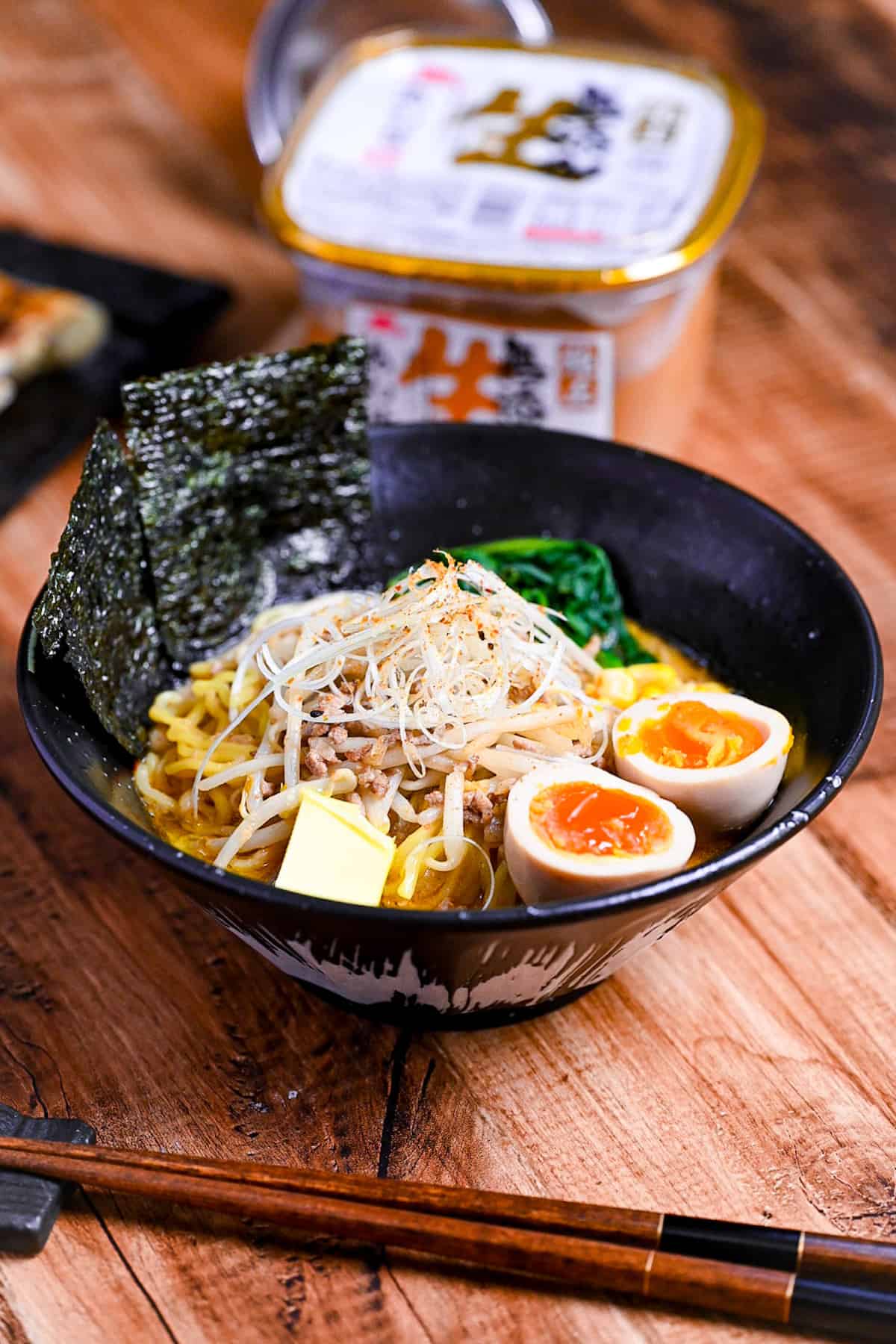
Visual Walkthrough & Tips
Here are my step-by-step instructions for how to make Easy Miso Ramen at home. For ingredient quantities and simplified instructions, scroll down for the Printable Recipe Card below.
If you prefer to watch the process in action, check out my YouTube video of this Miso Ramen recipe for a complete visual walkthrough!
Bring a small pot of water to a rolling boil and add a bit of salt. Drop in the bean sprouts and place the spinach roots in the water with the leaves hanging over the edge of the pot.
After 30 seconds, submerge the spinach leaves and cook everything together for another 30 seconds.

Everything goes straight into ice water to lock in that green color and stop the cooking.

Measure out 500ml of freshly boiled water. In a heat-proof container, whisk the peanut butter (unsweetened and unsalted), ground toasted sesame, and chicken bouillon powder with just a splash boiling water until it becomes a smooth loose paste.


Once the paste loosens, pour in the rest of the water and give it a good mix. Set it by the stove for later.


Peanut butter delivers instant creaminess and a roasty note without simmering pork bones for hours. Then sesame lends a familiar Japanese aroma, so the soup feels comforting, not too exotic.
If you don’t want to use peanuts, try using sesame paste or tahini instead.
Set a skillet (wok is a good option here) over medium heat. As soon as it’s warm, drop in unsalted butter and lard.

When the fats shimmer, add the grated garlic & ginger, and the white part of the Japanese leek. Lower the heat to medium-low, then stir-fry gently until they’re a little bit browned and release a great aroma.

Slowly stir-frying activates enzymes, which soften the pungency and enhance the sweet aroma. Garlic is also prone to burning over high heat, so gentle heating brings out its flavor without bitterness.

Raise the heat back to medium and crumble in the ground pork. Cook until no pink remains and the edges caramelize, about 3 minutes.

Splash in soy sauce, mirin, sugar, oyster sauce, and toban djan.

Stir until the pan looks almost dry and the pork is properly browned all the way.

Pour the nutty broth into the skillet. Use a spatula to scrape up the browned bits. That gives our broth even more depth!

Keep the heat on medium-high until small bubbles skitter across the surface, then cut the flame.
Place awase miso in a fine strainer or ladle. Dip the strainer or ladle into the hot broth and whisk until all of the miso has mixed thoroughly.

Swap some of the awase miso for red miso to enjoy extra umami and a richer color.
Miso’s fruity esters start to vanish above 85 °C (185 °F). By mixing it off-heat you keep the full essence in your bowl.
Boil the ramen noodles according to its package but pull them out 30 seconds early.

The residual heat of the broth will finish the chew. Shake the colander to drain well.
Divide the hot noodles into bowls.

Ladle over the miso broth with its savory pork, then add the sprouts and spinach. Scatter chopped green onions and sweet corn, tuck in a sheet of nori, and ramen eggs on top.

Last, drop in a pat of butter and watch it melt into a glossy layer that keeps the soup steamy.
- Chashu: Tender soy-braised pork slices that add rich, smoky protein
- Menma: Crunchy fermented bamboo shoots for salty-savory bite
- Caramelized onion: Soft, golden onion strips that deepen the soup’s natural sweetness
- Raw diced onion: Fresh, sharp crunch to cut through the miso’s richness
- Grated ginger: Bright, warming zing for a mid-bowl flavor refresh
- Cooked Wontons: Silky dumplings that soak up broth and add textural contrast
Drizzle a tiny bit of toasted sesame oil or chili oil over each bowl. Think it’s too rich? You can add a splash of black or rice vinegar to mellow it out.
Jump to Full Recipe Measurements
Essential Tips & Tricks
- Ice bath the vegetables immediately – After blanching bean sprouts and spinach, plunge them straight into ice water to lock in vibrant green color and prevent overcooking.
- Whisk peanut butter with hot water gradually – Start with just a splash of boiling water to loosen the paste, then add the rest slowly to avoid lumps in your broth base.
- Scrape up the browned bits when adding broth – Those caramelized pieces stuck to the pan are pure flavor gold.
- Never boil miso paste directly – Dissolve it in a strainer off the heat to preserve delicate fruity esters that disappear above 85 °C (185 °F).
- Drain noodles thoroughly – Shake that colander vigorously to remove excess water that would dilute your carefully crafted broth.
With these simple tips in mind, you’re set for success every time you make Miso Ramen.
Meal Prep & Storage
This miso ramen isn’t ideal for full make-ahead bowls (noodles turn soggy and miso aroma fades fast), but you can prep several components.
- Savory Pork Topping: Cook the pork with its seasonings, cool, and pack in an airtight jar. Refrigerate up to 3 days or freeze 1 month. Reheat until piping hot before assembling.
- Nutty Broth Base (without miso): Whisk the peanut-sesame broth, bring to a brief simmer, cool, and store in a quart container. Refrigerate 3 days or freeze 1 month. Reheat, then whisk in fresh miso off-heat so the fragrance stays bright.
- Soft-boiled eggs: Prepare ramen eggs up to 5 days ahead.
Store all components in airtight glass containers in the refrigerator. Cool everything to room temperature before refrigerating to prevent condensation. Never store cooked noodles, always cook them fresh for the best texture.
Serving Suggestions
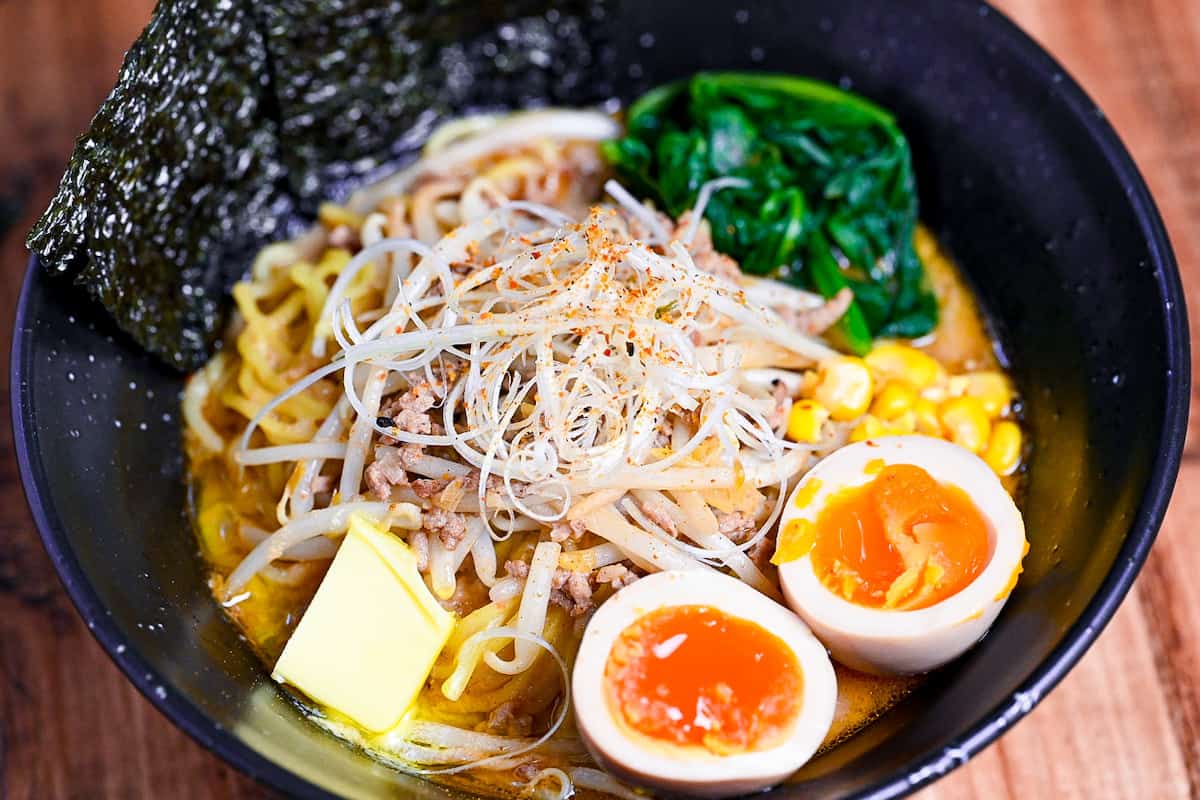
FAQ
Here are answers to frequently asked questions I have received across all platforms, including here, YouTube, Instagram, and Pinterest. If you have any questions, feel free to send them to me anytime! It will be a big help for everyone in this community!
Miso is a savory paste crafted from fermented soybeans and comes in several varieties. While you can use miso paste for this recipe, I recommend starting with awase (yellow) miso.
For best results, boil your ramen noodles for 30 seconds less than the package states. Add the freshly-cooked noodles immediately to the soup for the best ramen experience, whether at a restaurant or home. Any amout of waiting can make the noodles mushy as they absorb the broth, diminishing the dish’s quality. Quick action is vital.
This issue often arises from boiling fresh ramen noodles in insufficient water. Use a large pot and plenty of water (just like you would do to cook pasta) to prevent excess starch from adhering and thickening your soup.
The original Sapporo miso ramen emerged at “Aji no Sanpei” restaurant when a chef creatively combined elements of tonjiru (pork miso soup) with ramen. Born from Hokkaido’s cold climate, it featured innovations like lard-topped broth to retain heat and specially developed noodles that stayed firm longer. These techniques made it the perfect warming dish for harsh winters.
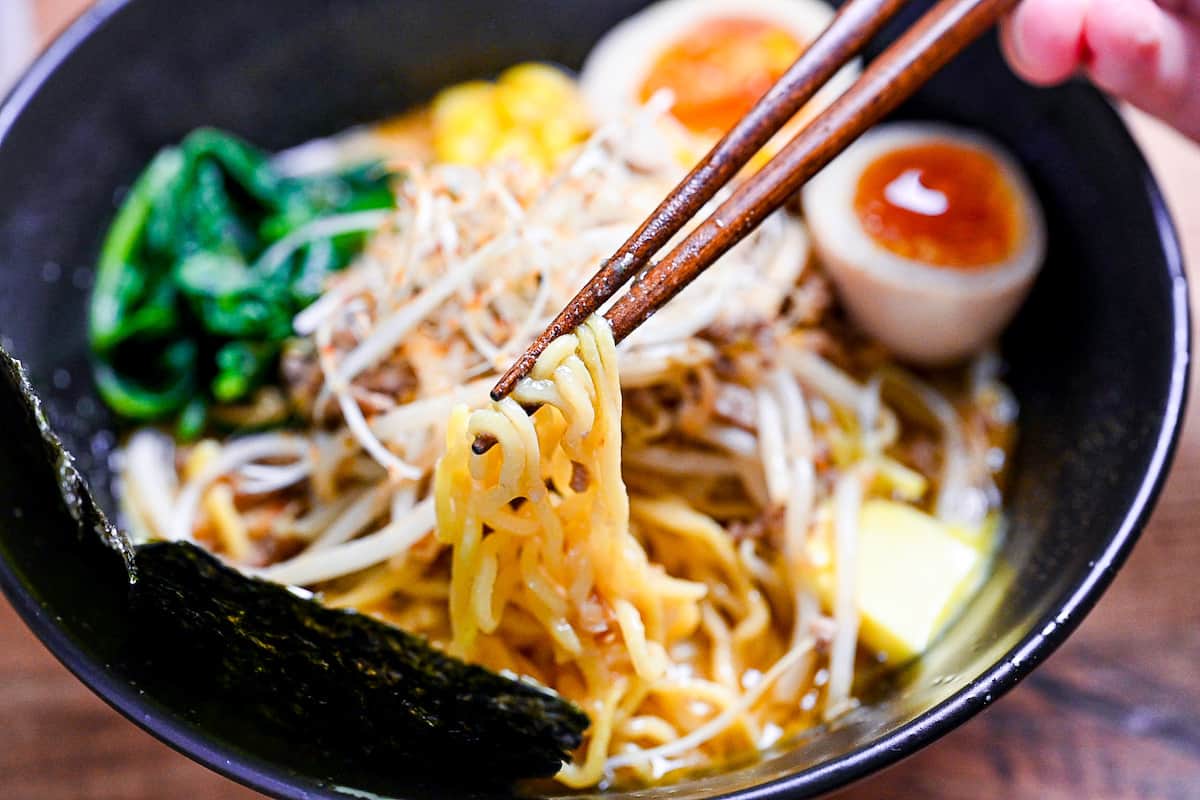
I hope you enjoy this Easy Pork Miso Ramen recipe! If you try it out, I’d really appreciate it if you could spare a moment to let me know what you thought by giving a review and star rating in the comments below. It’s also helpful to share any adjustments you made to the recipe with our other readers. Thank you!
More Ramen Recipes
- Chicken Shio Ramen (Salt Base)
- Classic Shoyu Ramen (Soy Sauce Base)
- Tantan Ramen (Spicy Chinese-style)
- Spicy Tsukemen (Dipping Ramen)
Want more inspiration? Explore my Ramen Recipe Roundup for a carefully selected collection of tasty recipe ideas to spark your next meal!
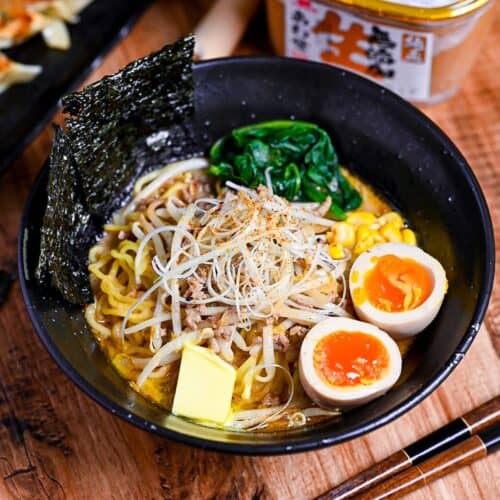
Pork Miso Ramen in 15 Minutes (Sapporo Style)
Equipment
- Noodle strainer
Ingredients
Broth
- 1 tbsp ground sesame seeds
- 1 tbsp smooth peanut butter or sesame paste/tahini
- 1 tsp Chinese-style chicken bouillon powder
- 500 ml freshly boiled water
- 1 ½ tbsp yellow miso paste (awase) added at the end
Seasoned Pork
- 1 tsp butter
- 1 tsp lard
- 4 cloves grated garlic
- 1 tbsp grated ginger root
- 2 tbsp Japanese leek (naganegi) white part, finely diced
- 150 g ground pork
- 1 tsp Japanese soy sauce (koikuchi shoyu)
- 1 tsp mirin
- 1 tsp oyster sauce
- ½ tsp sugar
- ½ tsp chili bean sauce (toban djan)
Toppings & Noodles
- 30 g Oriental spinach
- 100 g bean sprouts
- 2 portions ramen noodles
- canned sweet corn
- finely chopped green onions
- butter
- ramen eggs or soft boiled eggs
- roasted seaweed for sushi (nori)
My recommended brands of ingredients and seasonings can be found in my Japanese pantry guide.
Can’t find certain Japanese ingredients? See my substitution guide here.
Instructions
- Prepare a bowl of ice water and set it by the stove. Bring a pot of water to a rolling boil and add a pinch of salt. Add 100 g bean sprouts and the thick stem part of 30 g Oriental spinach to the pot and boil for 30 seconds.

- Submerge the leaves of the spinach and boil for another 30 seconds before transferring them to the ice water bath. Set aside for later.

- Add 1 tbsp ground sesame seeds, 1 tbsp smooth peanut butter, and 1 tsp Chinese-style chicken bouillon powder to a heatproof bowl or jug. Measure out 500 ml freshly boiled water and add a splash to the bowl.

- Whisk until smooth before adding the rest of the water and set by the stove for later.

- Heat a large wok over medium and add 1 tsp butter and 1 tsp lard. Once melted, reduce the heat to medium low and add 4 cloves grated garlic, 1 tbsp grated ginger root and 2 tbsp Japanese leek (naganegi). Mix occasionally to prevent burning and fry until fragrant.

- Increase the heat to medium and add 150 g ground pork, fry until cooked through and slightly browning around the edges. Then add 1 tsp Japanese soy sauce (koikuchi shoyu), 1 tsp mirin, 1 tsp oyster sauce, ½ tsp sugar and ½ tsp chili bean sauce (toban djan). Stir fry until the pork is evenly coated and thoroughly browned.

- Add the nutty broth from earlier to the wok and mix well, scraping the edges of the pan as you go. Bring to a boil then turn off the heat. Place 1 ½ tbsp yellow miso paste (awase) in a miso strainer, dip it in the broth and whisk thoroughly to incorporate it into the broth.

- Boil 2 portions ramen noodles for 30 seconds less than the time stated on the packaging.

- Drain the noodles thoroughly and rinse with hot water to remove excess starch. Shake thoroughly, then divide them between serving bowls and top with the soup.

- Squeeze the spinach thoroughly and shake the beansprouts to remove any excess water. Arrange them on top of the noodles along with canned sweet corn, finely chopped green onions, ramen eggs, roasted seaweed for sushi (nori) and a small pat of butter. Enjoy!

Video
Notes
- Taste the soup right before plating. Add hot water if salty or tiny bit of soy sauce if flat.
- Cook noodles last and serve within 10 seconds of draining to keep them firm and springy.
- Refrigerate the seasoned pork topping up to 3 days or freeze 1 month. Reheat until steaming before use.
- If you must save leftovers, store noodles and broth separately. Reheat broth to a simmer and flash noodles in hot water for 5 seconds.
- The nutritional value is calculated based on drinking all of the soup. I don’t recommended finishing up the soup in this recipe.
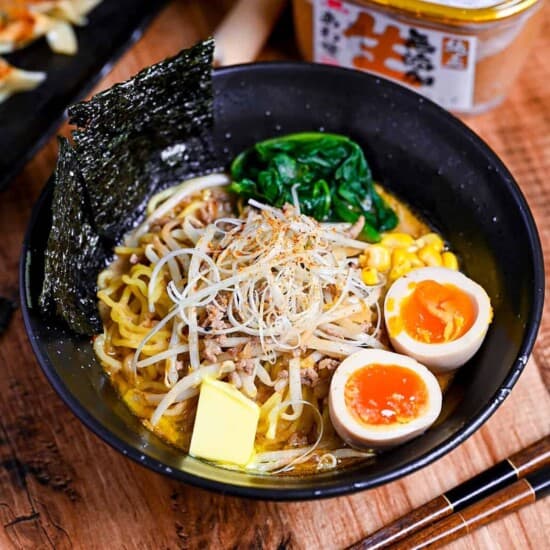





Hi!
What kind of smooth peanut butter is it?
Can I buy the noodles online? I can’t find it here where I live. Thank you!
Hi Michele!
Thanks for your question! I personally used Skippy, but it’s fine to use other brands as long as it’s the smooth kind. Skippy is known for being a bit salty and having more of a “roasted” flavour so I recommend it!
You should be able to buy ramen noodles online (they have them on Amazon etc) but if you can’t get them, you could try out my “ramen noodles made with spaghetti hack” https://sudachirecipes.com/ramen-noodle-hack-recipe/
Hope that helps, happy cooking! 🙂
This ramen recipe was so good! It was easy to make, too. The miso got it close to tasting like my favorite local restaurant ramen. I’ll definitely be making it this way from now on.
Hi Misty,
Thank you for your comment! I’m happy to hear that you enjoyed this recipe! 🙂
Yuto
Hi Yuto,
Greetings from Brazil! We tried the recipe today, we loved it! The idea of making a broth with bones and other ingredients, spending much time and effort, it wasn’t very encouraging. Thanks for simplifying everything with a delicious result my mother approved it
Hi Saulo,
Thank you for trying this recipe! That truly means a lot. I’m so glad you all enjoyed it, and especially that your mom gave it the thumbs up! Thank you for taking the time to share this! 🙂
Yuto
Thank you for the incredible tasty food. I’ve been following your site for a while now and always have success with your recipes. Just had to comment. I’m going to try the pork miso ramen today.
Hi Nina,
Thank you so much for your kind words! I’m really happy to hear you’ve had success with my recipes. Your support means a lot to me. I hope you love the pork miso ramen – let me know how it turns out!
Yuto
I love the idea of using peanut butter in the soup! It was so easy and tasty!!!
I didn’t have Chinese chili bean paste so used Korean. Still turned out very well.
Hi Jas,
Thank you so much for trying this recipe and sharing your experience! I’m happy to hear that you enjoyed the peanut butter trick, and it’s great to know that Korean chili paste worked well as a substitute!
Yuto
Your recipes are awesome – they are always so so good and easy to make. Thank you for sharing then with us. Loving the idea of peanut butter in this dish. Looking forward to making it.
Hi Ja,
That really means a lot! I’m happy the recipes have been working well for you! Hope you enjoy this peanut butter twist when you try it
Yuto
Fabulous – we loved it!
Thank you so much, Rob! 🙂
thank for all the details and the information about miso, very useful for non Japanese who want to learn more about your cuisine
Hi Esther,
Thanks so much! I’m really glad the details on miso came through clearly and were useful to you. 🙂
Yuto
WOW! This was way better than most restaurant ramen we have here in the US. so many complex yet complimentary flavors. This will be a staple in our household now!
we did swap out some of the ingredients with things we had on hand! we used chicken instead of pork and sesame paste instead of powder. The sesame paste likely made the broth a tad thicker but the taste was incredible! This is definitely a recipe you can adapt slightly for things you have on-hand!
Always love all of Sudachi’s recipes!
Hi Jacque,
It’s been a long time! Hope you and your loved ones are doing great.
Thank you for sharing your feedback and lovely comment! I’m happy you enjoyed it and that it worked with your adjustments. 🙂
Yuto